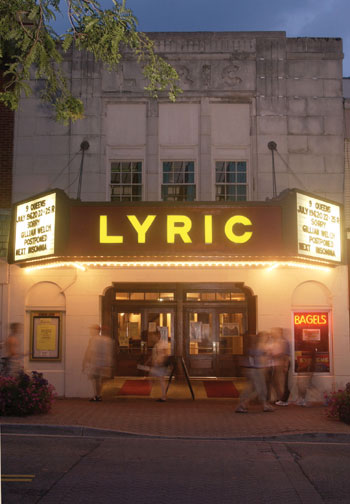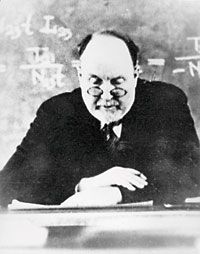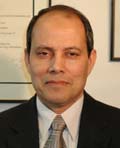 |
|
|
The picture of the Lyric Theatre shown in the fall issue of Virginia Tech Magazine brought back many memories of my years at VPI. I walked through the entrance to the theatre--which looks almost like it did 50 years ago--thousands of times. I entered Tech in the fall of 1952 as a married Korean War veteran. It soon became apparent that we could not subsist on the G.I. Bill benefits while I was in school. Since I had trained as a projectionist in the Navy, I went to the Lyric Theatre [to find a job]. Phil Oliver, an Army sergeant assigned to the ROTC unit at Tech who worked as a projectionist to help support his large family, hired me to run the matinee movie. Less than a year later, Phil was transferred to Korea and I took over as projectionist. Students who attended the Lyric in those days will remember more than one time when the screen went white because I was so deep in study that I had missed the cue to make the change-over and the reel of film had run out. Phil Oliver returned to Blacksburg and ran matinees for me until I left. We remained friends until his death several years ago. Thanks for reminding me of my days at Tech and the Lyric Theatre. If the Lord allows me the health and means, I hope to return to that beautiful campus next year to become a part of the Old Guard. John Cunningham '56 | Bainbridge, Ga. The article "Metropolitan Blacksburg?" by Juliet Crichton brought back many fond memories of VPI. The picture of the Lyric reminded me of the few times that my academics allowed me to go there. Just down the street was Meredith's Diner. Although the students called it "The Streetcar Named Di," the diner's food was very palatable. When I arrived in Blacksburg from NASA Langley to earn my master's in aerospace engineering during the '56 and '57 summer quarters, Randolph Hall was almost brand-new. I rented a garage on old Turner Street for my VW for $5 per month. Lucky me! My dorm in '56 was behind Lane Hall and opposite the laundry. To my surprise, I was awakened the first day by a steam whistle at 7:30 a.m. To avoid this during the next summer, I moved into Monteith. There were many positive things that I experienced at VPI. In those days, probably due to the corps, it was a simple custom to greet anyone that you encountered, including the staff and townspeople, with a "hello." Class pride was also a part of the VPI experience. In many places, one could find a sign that had the graduation year written over the word "ALL." Closing out my trip down memory lane from the fall issue was Clara B. Cox's article on Joseph "Pop" Owens. I was not aware at the time that the chapel that I attended was built by Pop and VPI students. What a great revelation! Dennis F. Hasson '58 | Severna Park, Md.
Richard G. Cocke '74 | Altavista, Va. I think that all sophomore engineers encountered Professor Rasche. He demanded attention in his class and he would intimidate you to get it. He called me "Mud Daubber" because of my name. The quadrangle lore was that he disliked freshmen because they were going to be sophomores, and he disliked juniors because they had been sophomores. He touted the seniors as "Skippers" who strutted around in their "Senatorial togas." I, at 89 and feeble, think most fondly of my days at Tech. Harold Muddiman '37 | Lake Junaluska, N.C. I got a real charge from the article about the inimitable Professor Rasche. I was fortunate to be one of his students in 1944. His mechanism class was a combination of psychology, ethics, personal grooming, English grammar and composition, public speaking, and, if he had the time, mechanism. His mathematical solution to gear-train relationships was truly a work of genius. Out of the clear blue one day, he revealed the source of his nickname; what led him to do so is a mystery. You're correct about the carnival, which was in Christiansburg. He told us that there was a caged gorilla that some of his students decided had a remarkable resemblance to Rasche (must have been the goatee), and the gorilla's name was Bosco. He seemed to enjoy telling this story to a bunch of soph-o-mores! He also told us that he was asked by General Motors to solve a gear problem the company encountered with its brand-new Hydra-Matic transmission. [GM] had requested multiple engineering drawing copies of his solution but he told us with a big smile and great delight, "I sent them the solution on the back of a penny postcard!" Then, as he often did following some profound revelation, he stated that it was a perfectly reasonable reply and went around the class asking, student by student, "Don't you think so?" Naturally, all hands always agreed. It seems he attended several different schools, took the classes he wanted, and never graduated from any of them. Professor Lee (of the electrical engineering department) claimed that with all that education, Bosco couldn't even operate a simple pencil sharpener. No one had the nerve to test him on that. He was a veritable fountain of information and wisdom. But you knew not to fall asleep in his class. I did that only once. And once was enough! Calvin T. Lucy Jr. '47 | Midlothian, Va. I enjoyed the feature "Rasche Hall: A plain monument to a colorful character." Although the story seems to give the impression that Rasche Hall has always housed cadets, Rasche was a civilian dorm for a period of time. I served as head resident advisor there my senior year, 1975-76. At that time, male cadets were housed next door in Brodie Hall, with female cadets occupying part of Monteith Hall. Living adjacent to the corps not only gave us an up-close look at a Virginia Tech tradition but it sometimes provided interesting challenges for our RA staff. Late one afternoon, several members of the corps regimental staff appeared in full dress uniform at my door to report that one of our residents had placed a stereo speaker on a ledge outside his window and was playing "Dixie" so loudly that the cadets could not hear commands to form up for their march to dinner. The resident was persuaded to remove the speaker and the cadets made it to Schultz Dining Hall in time for dinner. Jim Swope '76 | Palm Harbor, Fla.
In the Winter 2006 article "Hot topic: Global warming," Saifur Rahman gave credit for global warming to the burning of fossil fuel. Global warming started long before the Industrial Age. At one time, the Arctic ice came down to the Ohio River. Today, it is north of the Arctic Circle. When Leif Ericsson landed on Greenland, he named it that because it was green with grass. Today, Greenland is covered by ice. The Balfore Island was covered with trees. The trees are still there but they are frozen. In 1442, Florida was bigger than it is today, and 500 years from now--if the trend continues--it will have less dry land than today. There is no question that the Earth's temperature is rising. It has risen half a degree in the past 100 years. But is carbon dioxide the total cause of global warming? Russia and Eastern Europe are having one of the coldest years in recorded history. It could be that the trend toward global warming is temporary. Lawrence B. Lyon Jr. '50 | Madison, West Virginia Great article on global warming. Too bad the author didn't discuss human population increase as the root cause. Matt Perry '70 | Laurel, Md. Editor's note: Professor Saifur Rahman, the expert interviewed for the article, replies to these letters: "In response to Mr. Lyon's letter, it is better to use the term 'climate change' than 'global warming.' It is now a non-disputed fact in the scientific community that anthropogenic emissions of greenhouse gases are precipitating climate change. This climate change is primarily evidenced in many parts of the world by increased temperatures but also can be seen in weather that is drier, colder, wetter, or hotter than normal. Carbon dioxide is not the only greenhouse gas--others include methane, sulfur hexafluoride, nitrous oxide, and chloro-fluorocarbons--but it is the most common in volume. Data from the past 10,000 years suggest that the atmospheric concentrations of CO2 today are the highest ever, and there is a definite impact of those concentrations on the greenhouse effect, which previously was never experienced. "In response to Mr. Perry's letter, human population increase certainly impacts global warming because more humans, of course, use more energy, but the increase in population is not proportional to the greenhouse gas emissions. For example, the population increase in the developing world over the past 150 years has been several fold compared with that in the industrialized world. Yet, more than 80 percent of the greenhouse gas emissions in this timeframe came from the industrialized world. So, in terms of emissions, the level of industrialization is a better metric than the population increase. "For more examples and data on the topic of greenhouse gas and climate change, please go to www.ceage.vt.edu, particularly the Loring lecture given Dec. 7, 2006."
Readers may notice that this issue of Virginia Tech Magazine looks a bit different. Welcome to the first issue of the newly redesigned magazine! In keeping with the university's new branding campaign (see "A brand-new day at Virginia Tech"), we have refreshed the look of the magazine for the first time in 10 years. We're pleased with the results--and hope you are, too. Let us know what you think; send an e-mail to vtmag@vt.edu or write to Virginia Tech Magazine, 105 Media Building, Blacksburg, VA 24061.
The Fall 2005 article "Fralin's simple words are shaping the future" notes that Horace G. Fralin (electrical engineering '48) "enrolled at VPI, but two years later, at 18, interrupted his studies to serve in the Army during World War II." However, Calvin T. Lucy Jr. (electrical engineering '47) contacted the author to note that he and Fralin had served in the U.S. Navy, a fact that was confirmed by Fralin's brother, Heywood Fralin. We appreciate the correction and apologize for any confusion this may have caused.
Interested alumni can also write to Virginia Tech Alumni Association, Holtzman Alumni Center (0102), Blacksburg, VA 24061; or call 540/231-6285. Finally, the second official class ring debuted in 1912, not 1913, as stated on page 15. To learn more about the university's ring tradition, contact Laura Wedin or go to www.alumni.vt.edu/classring/tradition.htm. |




